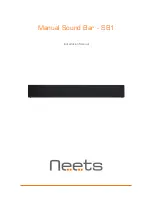
8
3
☞
☞
Volume control
This control allows you to balance the output from the subwoofer to the main speakers/
amplifier in your system. This control should be set to achieve similar output level from
both the main speakers and subwoofer when listening to music. A good starting point for
the volume control is 4 or 5 dots from minimum.
Low-pass crossover- 40 to 120Hz
The line-level inputs sum the left and right channels together, with the resulting signal
passing through an adjustable low-pass crossover before being amplified. The crossover
control allows you to adjust the upper limit of the subwoofer's frequency response from
40 to 120Hz. The subwoofer's output will be reduced above the frequency you set this
control to. You should set the crossover frequency to obtain a smooth and seamless
transition from the subwoofer to the main speakers in your system. If your main speakers
are smaller units with limited low frequency output, you may wish to choose a higher
frequency (such as 100-120Hz) than you would with larger speakers which have greater low
frequency output. With larger speakers, you might start with this control set lower, such
as 80Hz.
A bypass switch is also provided if you wish to use an external crossover.
If you are not
using an external crossover, we recommend that you use the one provided
within the unit for optimum performance!
Phase adjustment- 0˚/180˚
This control allows you the "reverse" the phase of the subwoofer's output signal 180˚ to
correct for any possible mismatch & resulting cancellation between the subwoofer and
your main speakers/amplifier. To adjust, simply listen to the system with music playing.
Then move the switch from one position to the other and listen for a change in low
frequency output. The correct position will have a greater amount of apparent low
frequency output.
Subsonic- 20Hz/35Hz
This adjustment alters the low frequency limit of the subwoofer. In certain movie theater
installations which suggest that the extreme low bass be limited, move the switch position
to 35Hz and the response will be attenuated below this frequency.
Protection circuitry
––––––––––––––––––––––––––––––––––––––––––––––––––––––––––––
Your new subwoofer is equipped with special protection circuitry to provide maximum
performance with greatest reliability.
The unit is protected against:
1) Overdriving the speaker or amplifier.
2) Overheating the amplifier.
3) Excessive drop in power line voltage.
The first type of protection circuitry which prevents overdriving of the speaker or amplifier
operates constantly without being audible under most situations. In some extreme
situations (sustained high output levels such as pro sound usage), the unit may shut down
momentarily. This indicates operation of the thermal or undervoltage protection circuitry.
If this should happen, you should reduce the volume setting or shut the unit off until
normal operating conditions return. You may also want to plug the unit into a different wall
outlet, as dropping power line voltage will be most noticeable under strenuous conditions.
Distortion in loudspeakers
––––––––––––––––––––––––––––––––––––––––––––––––––––––––––––
Nonlinear distortion is a problem which plagues all speakers. This particular type of
distortion is a common problem in subwoofers, which must move large amounts of air to
produce adequate levels of deep bass. Nonlinear distortion is defined as any form of
distortion that moves energy from one portion of the audio frequency spectrum to
another. When a single tone is applied to a nonlinear system, the result is harmonic
distortion. In which some of the energy leaves the system at multiples of the original
frequency. When multiple tones are applied, intermodulation tones are produced, usually
as simple combinations of the input frequencies. Generally, 3% distortion is considered a
reasonable amount for speakers. This means that 3% of the total energy leaving the speaker
is at frequencies other than the intended input signal.
Most subwoofers on the market today however, produce much more than 3% distortion
at common listening levels. Many models we have tested produce greater than 20%
distortion @ 20Hz when driven to 100dB. This is a typical output level obtained in many




























